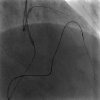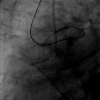Case presentation
The case is a proximal LAD CTO, with an ambiguous proximal cap, about 20mm length, distal landing is at the bifurcation, and interventional septal collaterals, which approached by bifemoral 7F system ( Video 1). Antegrade wiring of Gaia 2 had stayed outside the distal vessel ( Video 2), so a retrograde wire crossing attempt was made from a PDA to LAD ( Figure 1).
Although a Sion wire successfully crossed a septal but exited at the distal cap of the CTO ( Video 3). After confirmation that a Corsair pro microcatheter (Asahi Intecc, Japan) could advance beyond the distal cap ( Figure 2), which was replaced by a 2.5 mm x 20 mm OTW balloon (Ryujin, Terumo, Japan) over a trapping ballooning.
The balloon was advanced into the edge of the distal cap of LAD (Figures 3, 4), where an attempt was made to apply an extended CART (re-entry by an antegrade wire for targeting a balloon beyond the CTO, since CART is defined as a wire re-entry mediated by a balloon dilation inside CTO).
In this case, successful re-entry of Confianza Pro 12 was confirmed by wire overlaying in orthogonal projections ( Figure 5), followed by the wire exchange to a workforce wire, over which full balloon dilation and DES deployment ( Figure 5) achieved an excellent recanalization ( Video 4).
This case illustrates that a classic CART modification can help recanalize the complex anatomy of CTO. However, the disadvantage of this method is a need for stiff wires for re-entry, and as a result, there remains a nonnegligible chance of subintimal wiring to the distal segment.









